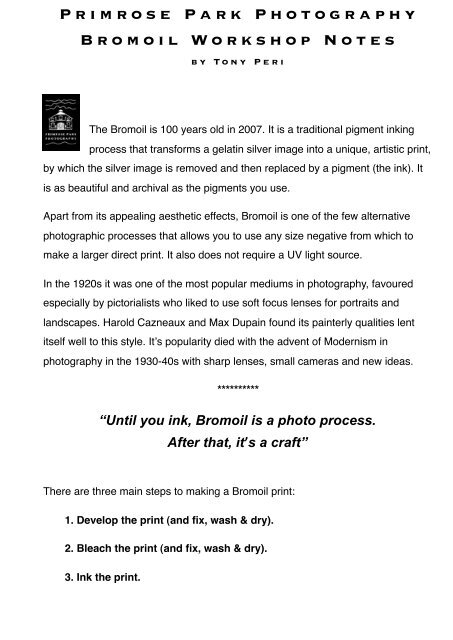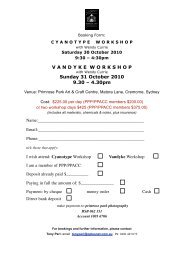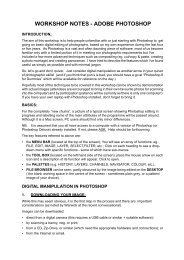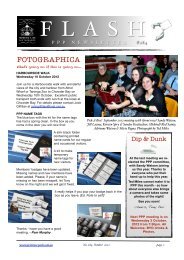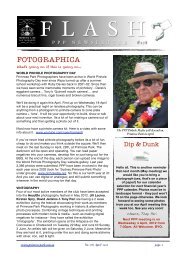Bromoil Workshop Notes.pdf - Primrose Park Art & Craft Centre
Bromoil Workshop Notes.pdf - Primrose Park Art & Craft Centre
Bromoil Workshop Notes.pdf - Primrose Park Art & Craft Centre
You also want an ePaper? Increase the reach of your titles
YUMPU automatically turns print PDFs into web optimized ePapers that Google loves.
P r i m r o s e P a r k P h o t o g r a p h yB r o m o i l W o r k s h o p N o t e sb y T o n y P e r iThe <strong>Bromoil</strong> is 100 years old in 2007. It is a traditional pigment inkingprocess that transforms a gelatin silver image into a unique, artistic print,by which the silver image is removed and then replaced by a pigment (the ink). Itis as beautiful and archival as the pigments you use.Apart from its appealing aesthetic effects, <strong>Bromoil</strong> is one of the few alternativephotographic processes that allows you to use any size negative from which tomake a larger direct print. It also does not require a UV light source.In the 1920s it was one of the most popular mediums in photography, favouredespecially by pictorialists who liked to use soft focus lenses for portraits andlandscapes. Harold Cazneaux and Max Dupain found its painterly qualities lentitself well to this style. It’s popularity died with the advent of Modernism inphotography in the 1930-40s with sharp lenses, small cameras and new ideas.**********“Until you ink, <strong>Bromoil</strong> is a photo process.After that, it’s a craft”There are three main steps to making a <strong>Bromoil</strong> print:1. Develop the print (and fix, wash & dry).2. Bleach the print (and fix, wash & dry).3. Ink the print.
P r i m r o s e P a r k P h o t o g r a p h yB r o m o i l W o r k s h o p N o t e sb y T o n y P e r iTO START - WHAT TO BRING:An apronDisposable/rubber glovesA black & white negative from which to make your print.Darkroom paper (8x10 Ilford Matt Fibre)Paper towelsA notebookLead pencilGlass jar for brush cleanup<strong>Art</strong>ists Brushes with round headsHairdryer
P r i m r o s e P a r k P h o t o g r a p h yB r o m o i l W o r k s h o p N o t e sb y T o n y P e r iEQUIPMENT & MATERIALS NEEDED FOR BROMOILING:PapersIlford Fibre Matt Paper (Packet of 8 x 10 inch, 25 sheets $40-45); ORFotospeed Rembrandt Paper (8x10) - Now deleted in Australia.Many papers good for <strong>Bromoil</strong>ing have long since been discontinued. You need to be able toswell the gelatin in the paper so it repells the ink. Many modern papers have hardeners in them,so will not work so well. Testing is needed for each brand and type of paper you try.EquipmentTwo pieces of glass slightly larger than the paper you intend using.A tile (or third piece of glass) for mixing up inks (approx. A5-A4 in size)Blotting paper ($1.05 ea A2 sheet) - 4 or 5 sheets minimum.Cotton wool pads <strong>Art</strong>ists Brushes. Preferably with a round head, like a shaving brush looks. 2-3 minimum - Some are for applying ink, others are for removing it. Soapy brush cleaner solution - one that won’t ruin your brushes but removes ink.Small artists spatula for mixing pigment Black Ink (Indian Ink) & pigments for mixing into inks (for advanced users).
P r i m r o s e P a r k P h o t o g r a p h yB r o m o i l W o r k s h o p N o t e sb y T o n y P e r i1. DEVELOPING THE PRINT:CHEMICALS - Developing the Print: Non hardening paper developer - Kodak Dektol (Use 1+9)Non hardening fixer - 10% solution of plain HypoHypo Clearing AgentThe aim here is to develop a LOW CONTRAST looking print 1-2 STOPS darkerthan normal.Use a ‘00’, ‘0’, ½ or ‘1’ filter with multi-contrast paper. For graded papers(Rembrandt Paper is grade 2½ ) start with a good evenly-toned/zonednegative.Leave a white borderMake a black border around the edge of the print1. Develop in Dektol 1+9 for 3 minutes at 20˚2. Rinse/wash in water for 30-60 sec (don’t use stop bath)3. Two-bath fixer (2 + 2 minutes)4. Rinse/wash in water for 30-60 sec5. Hypo clearing agent (agitate continuously for 3 minutes)6. Wash print for 20 minutes minimum.7. Dry print
P r i m r o s e P a r k P h o t o g r a p h yB r o m o i l W o r k s h o p N o t e sb y T o n y P e r i2. BLEACHING THE PRINT (TO THE MATRIX)CHEMICALS - Bleaching the Print:Copper SulphatePotassium BromidePotassium Bichromate or Potassium Dichromate7% Acetic AcidDistilled Water (if water is ‘hard’)Non hardening fixer - 10% solution of plain HypoHypo Clearing AgentFIRSTLY, make sure the print is BONE DRY.Super drying the print strengthens the gelatin. You can use a hair dryer oroven for a few minutes, even 24-48 hours after air drying to make it super dryof any moisture. (You will super dry the print again before the inking stage.)Bleaching the print can be done with the lights on inside, though it would be best to avoidharsh/strong light like sunlight.
P r i m r o s e P a r k P h o t o g r a p h yB r o m o i l W o r k s h o p N o t e sb y T o n y P e r iBLEACHING THE PRINT (Continued…)1. Super Dry the print2. Soak the print in water for 5-10 minutes at 20˚-24˚3. Bleach the print in <strong>Bromoil</strong> Bleach solution diluted at 1 + 3 for 5-20 minutes. Agitate continuosly or any air bubbles will show up later as white spots. The image should almost disappear and be a faint green colour in the shadows. If it is a reddish colour you have not fixed the print properly.4. Rinse for 30-60 seconds5. Wash bleach out of print for 15 minutes6. Two bath fixer (2 + 2 minutes)7. Rinse/wash for 30-60 seconds in fresh water (not in bleaching wash)8. Hypo clearing agent (agitate continuously for 3 minutes)9. Wash print for 20 minutes minimum and then dry.“<strong>Bromoil</strong> Bleach Formula” Stock solution★★★★★Copper Sulphate - 60gPotassium Bromide - 60gPotassium Bichromate or Potassium Dichromate - 3g7% Acetic Acid - 14 mlDistilled Water (if water is ‘hard’) to make 2 litres.Use 1+3 with water and use a fresh batch for EACH print. Only a small amount needed per tray but agitateconstantly. Eg: A 16 x 20 print needs only 800ml of bleach (ie 200ml bleach + 600 ml water).
P r i m r o s e P a r k P h o t o g r a p h yB r o m o i l W o r k s h o p N o t e sb y T o n y P e r i3. INKING THE PRINT:EQUIPMENT & MATERIALSIndian Black Ink; pigments of various colours…BrushesBlotting paperGlass base for inking and washing onTile<strong>Art</strong>ists spatulas1. Super dry the Matrix print2. Soak the Matrix for 10 minutes (times vary with different papers) in water of 30˚-35˚ temperature. Build up temperature gradually or start with a 25˚ bath first.3. Ready your ink4. Charge your Brush5. Remove matrix from water6. Blot dry front and back. Paper should have no visible water droplets or ink willnot work and leave spots. While inking, paper should be moist.7. Leave ink to dry, but NOT the paper. Re-soak (be gentle when immersing inwater.)8. Ink should not move or wash off. Dab brush on print VERY GENTLY to start removing ink. Highlights should clear, shadows should stay.9. Remove print and repeat inking process until your print ‘inks up’.
P r i m r o s e P a r k P h o t o g r a p h yB r o m o i l W o r k s h o p N o t e sb y T o n y P e r iThere are no more rules - dab, brush, wipe or roll. Experiment and see.You don’t finish a print, the artist in you just has to know when to stop!The <strong>Bromoil</strong> can take a few days to dry depending on the temperature andweather, so be careful not to smudge the print.The finished <strong>Bromoil</strong> is archival and can be used to make a <strong>Bromoil</strong> Transfer(but that’s another workshop!)References:• “A Manual Of <strong>Bromoil</strong> And Transfer”, by Dr. Emil Mayer (1927)••“Historical Photographic Processes”, by Richard Farber“Coming Into Focus”, by John Barnier• “Bob’s <strong>Bromoil</strong> Express” by Bob Gumpper in POST-FACTORY Newsletter #6•••“The <strong>Bromoil</strong> And <strong>Bromoil</strong> Transfer Processes” by Bertram Cox“Working Up Prints In Oils” by H.A. Murch“Some Preliminary <strong>Notes</strong> On <strong>Bromoil</strong>” by Ed Buffaloe… and about 100 hours in the Darkroom working it out for myself!- Tony Peri,(September 2007)


